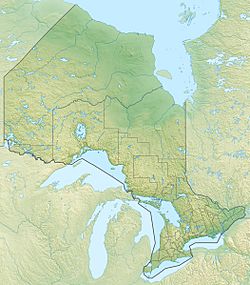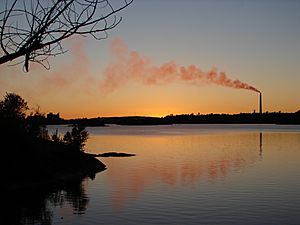Ramsey Lake facts for kids
Quick facts for kids Ramsey Lake |
|
|---|---|

View of Ramsey Lake from Science North Marina towards the Sailing Club.
|
|
| Location | Sudbury, Ontario |
| Coordinates | 46°28′N 80°57′W / 46.47°N 80.95°W |
| Basin countries | Canada |
| Surface area | 792.2 ha (1,958 acres) |
| Max. depth | 20.5 m (67 ft) |
| Shore length1 | 34.0 km (21.1 mi) |
| Islands | 7 |
| 1 Shore length is not a well-defined measure. | |
Ramsey Lake is a beautiful lake located in Sudbury, Ontario, Canada. It's right near the city's downtown area. For many years, Ramsey Lake was listed in the Guinness Book of World Records as the world's largest lake found entirely within a single city.
However, in 2001, the city of Sudbury grew much larger. It joined with other nearby towns to form what is now called Greater Sudbury. Because of this change, a bigger lake named Lake Wanapitei became part of the city. Lake Wanapitei is about 20 kilometers northeast of Ramsey Lake. Since Lake Wanapitei is larger, Ramsey Lake lost its special record.
The correct spelling of the lake's name is "Ramsey," though sometimes you might see it spelled "Ramsay." People also use both "Lake Ramsey" and "Ramsey Lake." Before the modern city of Sudbury was built, the local Ojibwe people had their own name for the lake: Bitimagamasing. This name means "water that lies on the side of the hill."
Contents
Fun Things to Do at Ramsey Lake
There are many exciting places to visit around Ramsey Lake!
Science North
Science North is a popular science museum located on the southwest side of the lake. During the summer, you can take a boat tour of the lake from Science North. This tour is called the William Ramsey boat tour.
Bell Park and the Boardwalk
The city's Bell Park is also very close to the lake. A special path called the Jim Gordon Boardwalk connects Science North and Bell Park. It's a great place to walk or bike along the lakeshore. Jim Gordon was a mayor of Sudbury who helped make the city a better place.
Laurentian University
Laurentian University is a big university located near the southern shore of Ramsey Lake. The neighborhoods just south of the lake are some of the nicest in the city.
Moonlight Beach and Conservation Area
On the eastern side of the lake, you'll find Moonlight Beach. This is a popular spot for swimming and relaxing. The Lake Laurentian Conservation Area is also nearby. It's a large natural park where you can enjoy outdoor activities and learn about nature.
Ramsey Lake's Amazing Comeback
Ramsey Lake has a really cool story about how it was cleaned up!
Cleaning Up the Lake
Years ago, the lake had a big problem with air pollution from nearby industries. Because the water didn't flow out much, the lake was considered "dead" for a long time. This meant very few plants or animals could live in it.
But in 1972, a very tall smokestack called the Inco Superstack was built. This stack helped spread the smoke from the smelters (places where metal is made) over a much wider area. This was the start of a huge project to clean up Ramsey Lake's water and bring back aquatic life.
A Successful Project
The cleanup project worked! It was so successful that it led to even more efforts to improve Sudbury's environment. One big project was planting many trees all over the city. In 1992, the United Nations gave Sudbury an award. This award recognized the city's amazing and new ways of cleaning up its environment.
Life in the Lake Today
Today, Ramsey Lake is full of life! It has many different kinds of fish, including walleye, northern pike, smallmouth bass, yellow perch, white sucker, pumpkinseed, and rock bass.
Sometimes, you might hear about blue-green algae growing in the lake. This is a type of algae that can produce toxins. It's important to be aware of this, especially during warmer months, and follow any warnings from local authorities.



